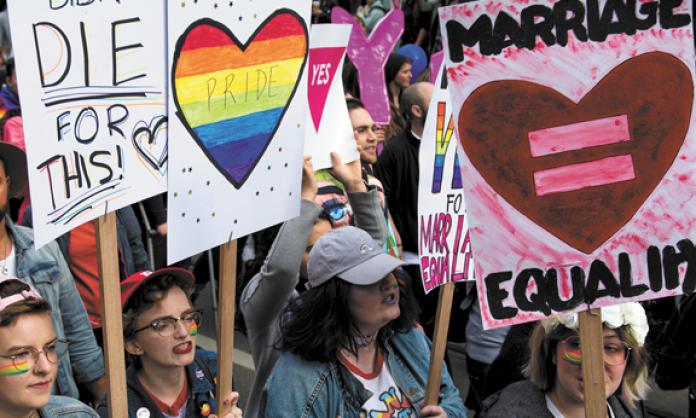The Yes campaign has been launched in the best way a postal survey campaign possibly could be: with a history-making mass mobilisation. More than 20,000 people, the largest demonstration for LGBTI rights in Australian history, packed into Melbourne’s CBD on 26 August to demand equal rights.
The rally demonstrated in living colour (and lots of it) the overwhelming support for marriage equality that polls show exists in Australian society. A broad cross-section of people were in attendance: university students, unionists, high school classmates, church groups, an array of political organisations and campaign groups, both LGBTI and non-LGBTI. The rally was organised by Equal Love, the activist campaign group that has since the beginning of the campaign sought to involve wider layers, via mass rallies, speak-outs and grassroots activism.
Attendees were demonstrating not only their support for equal marriage rights, but also their contempt for a government that would go to such great lengths to put barriers in the way of basic reform. The right wing, led by Tony Abbott and Eric Abetz, has called the shots on this issue since 2013, the postal survey being just their latest scheme to delay and derail equality.
Ironically, however, the postal survey farce has not had the effect of demoralising and dividing the marriage equality movement that the troglodytes hoped it would. Rather, it has been the catalyst for the creation of an even larger and more diverse coalition of individuals and organisations determined to act.
This is reflected not just in the enormous turnout to demonstrations, but also the hundreds of thousands who have enrolled or updated their details in order to vote, as well as the hundreds around the country who are coming to meetings or contacting campaigners to find out how they can help with the Yes campaign.
Indeed, more than any previous development in the campaign, the postal survey has generated a wave of enthusiasm and solidarity with LGBTI people that will be sending chills into the already frozen hearts of the government and the Christian right.
In addition to this, it has helped transform the issue from one perceived to be mainly, if not exclusively, the concern of LGBTI people to one of sudden concern to the approximately 12 million people who will be called on to consider the issue and take a side. For many without a personal stake in the outcome, this will be a question primarily of civil rights: the merits of standing with a group targeted and discriminated against by a conservative government versus cheering the government on.
Accordingly, society is lining up along its traditional battle lines, with the labour movement, the ALP, the left and progressive groups on one side, and the forces of political reaction – the Liberal and National parties and Christian right – mostly on the other.
A resounding victory for the Yes campaign has the potential not just to be a major win for LGBTI people, but also to strike a blow against the Turnbull government’s broader legitimacy. A victory for solidarity over the transparent divide and rule politics of a government that has nothing to offer ordinary people but cuts and austerity has the potential to undermine the powerlessness many feel in the face of this offensive.
And it can open wider layers of people to identification and sympathy with other groups cruelly targeted by this government, whether refugees, welfare recipients or Muslims.
Street demonstrations are a crucial element of such a campaign. More than most other actions, they help develop a sense of momentum, confidence and collective power that helps to embolden the many who attend to take the equality message into their workplaces, schools, universities and elsewhere. It helps to transform people from passive supporters into active participants in a campaign that will depend for victory on the actions of the millions around the country who support marriage equality. And it highlights major advantages the Yes side has over the No: numbers, passion, historical legitimacy and a determination to win.
This is all important because, for the Yes campaign to be successful, it needs not only to win, but to win decisively. The right wing will use any weakness – a small turnout or slim majority – as an argument to further defer reform. Our side needs to muster all the momentum and strength it can to inspire and mobilise people to be active campaigners for the Yes side, and massive street demonstrations couldn’t be a better way to start.
The prospect of a triumphant victory is a welcome development for a campaign that has had its ups and downs over its 13-year history. In addition to the manoeuvring of the right wing, there has been no shortage of quibbling from what should be more friendly quarters over whether or not marriage equality is a cause to be championed.
At times this has been from people seeking to justify the ALP’s initial support for the homophobic ban, and at others by those supposedly too radical to throw their weight behind a campaign demanding inclusion in an institution they don’t approve of. Others have complained that marriage equality sidelines other issues of importance to LGBTI people.
The current upsurge demonstrates the weakness of these arguments. A mass anti-government campaign to champion the rights of an oppressed group and oppose discrimination helps to raise consciousness about and sympathy towards wider LGBTI issues, and can bring greater attention to the variety of challenges faced by LGBTI people in every area of life.
Furthermore, the campaign has drawn a layer of people into political activism who would otherwise have likely remained passive, which can only be positive. And just as support for desegregation in the US South shouldn’t have hinged on approval or otherwise of Black people’s desire to consume diner food, support for civil equality in the case of LGBTI people shouldn’t be determined by the left’s attitude to the institution that the oppressed are demanding access to.
So while the postal survey is a ludicrous testament to the right wing’s obstinacy on this issue, ironically it has done more than any other development in this 13-year campaign to bring the issue of marriage equality into the public spotlight and to mobilise support. The challenge now is to maintain the momentum and win.









